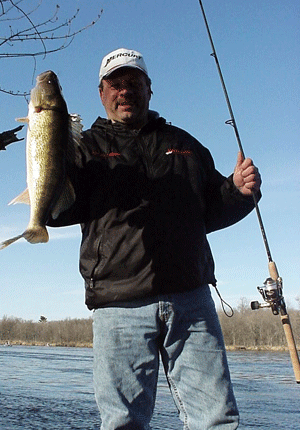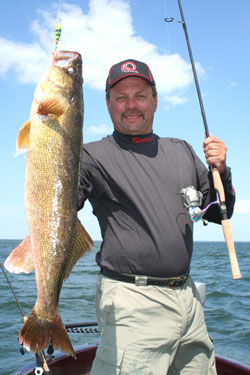On any given body of water, knowing where you have been will almost always help you determine where you should be going.
 There’s no substitute for experience, but the same can’t always be said for experiences. Sometimes, walleye anglers fall in love with certain areas or techniques that have been good for them in the past, and they overlook the current factors that actually dictate fish behavior.
There’s no substitute for experience, but the same can’t always be said for experiences. Sometimes, walleye anglers fall in love with certain areas or techniques that have been good for them in the past, and they overlook the current factors that actually dictate fish behavior.
We’ve all had days where a certain rock pile, point, sandbar or river bend has been loaded with quality fish, and it’s human nature to try to repeat that bonanza. But just because you pounded the fish there in April a couple of years ago doesn’t mean the walleyes will be there this year.
In fact, my personal list of phenomenal catches has included more one-and-done experiences than situations where I’ve returned to a familiar spot and repeated a great catch. I can probably list a spot or two that has been spectacular on every body of water I fish where I’ve never caught another walleye.
Of course, there are some exceptions and some spots that are always worth checking at certain times of the year when specific weather and water conditions exist. The important thing is that we don’t get hung up on history and burn valuable time that would be better spent elsewhere.
More important than knowing where the fish have been is knowing why they were there in the first place. That’s the type of experience that can be applied year after year as you try to determine a game plan for a current outing.
Usually, walleye location has more to do with seasonal migrations, forage, water conditions and weather than it does a “spot on the spot.”
April is a month that can include pre-spawn, spawning and post-spawn walleyes. Water temperature factors into what stage these fish are in, but other criteria contribute to triggering the spawn, as well, including the length of the photo period.
Let’s say it’s been an especially cold spring when the water temperature hasn’t climbed past the low 40s. That’s colder than what is generally accepted as spawning temperature.
If that’s the situation in early April here in the Midwest, we’re probably looking at mostly pre-spawn fish. Then we can develop a game plan accordingly, singling out likely staging areas in the vicinity of established spawning habitat.
If it gets to be mid- or late April with those conditions, some female walleyes will force the issue rather than wait for things to warm up. While most areas in a lake or river remain cold, a walleye can increase its body temperature and accelerate the spawning process by moving into shallower, warmer water.
When that occurs, it probably means it’s going to be a slow, extended spawn that lasts for a couple of weeks. We’ll want to poke around in the spawning areas during lowlight periods of the day, then work on pre-spawn fish the rest of the day.
If it’s a warm spring and the water temperature climbs rapidly, it could be a quick spawn where the majority of the walleyes get their business done over a short period of time. Then we can concentrate our efforts accordingly.
Modern electronics and mapping have made the challenge of locating these fish a lot easier than it was for our angling forefathers, and my Mercury-powered Triton 215X makes it quick and easy to get from one spot to the next.
Today, I can look at dozens of potential areas with Navionics GPS mapping and my Humminbird sonar as I attempt to find some fish.
 Armed with a general idea of what stage the walleyes are in, I know approximately where they should be in a given system. Navionics maps help me identify elements within those general areas that hold walleyes, such as breaklines, transitions and structure. Then, as I look over those areas, Humminbird lets me know if any fish are present.
Armed with a general idea of what stage the walleyes are in, I know approximately where they should be in a given system. Navionics maps help me identify elements within those general areas that hold walleyes, such as breaklines, transitions and structure. Then, as I look over those areas, Humminbird lets me know if any fish are present.
Once the spawn is history, the factor most affecting their lives is food. While some males will remain in spawning areas for days or even weeks, the females will disperse into other areas to recover and recharge.
In systems where a significant number of walleyes spawn in adjoining rivers, you may be able to intercept some fish as they flush back into the main lake. If not, you may find them in the first fertile bay north or south of a tributary. Where most of the spawning takes place on reefs, humps or on gravel flats, you may find postspawn walleyes stacked up on a nearby breakline or suspended nearby over deep water, especially if baitfish are present.
And then, as fish become even more removed from the spawn, factors such as weather and wind become more important when trying to determine their location. Walleyes are feeding heavily, and they seek out areas where they can do that with the least effort required.
That means wind-blown points or shorelines where the water is stirred up, or bays where the wind has been pounding in for an extended period of time. Cloud cover will usually keep spring walleyes shallow for longer periods. Sunshine tends to drive them from the shallows or at least keep them from feeding actively.
Catching these fish is the next piece of the puzzle. It doesn’t doo much good to know where they are if that area is unfishable because of current, flooding, lack of water clarity, etc. All of those factors have to be considered when choosing which spots to fish, as well.
Ultimately, each outing on the water is a new adventure. Experience can point us in the right direction, but we still have to interpret the current conditions and adjust our game plan accordingly.
Rarely does history repeat itself exactly. However, there’s always a reason walleyes are using a certain spot. Keep detailed notes regarding water temperature, clarity, depth, wind direction, time of year, stage of the spawn, presence of forage, etc., and you will at least have a foundation from which to begin.
When a familiar set of circumstances occur and you can’t get the fish to go at one spot, study your maps and seek out areas with similar characteristics where the water clarity, temperature or wind direction might be more favorable.
It’s tempting to go exactly where we’ve caught fish before.
It’s more practical to evaluate each situation on its own.
Then you’ll be ready to give the walleyes a little history lesson.










